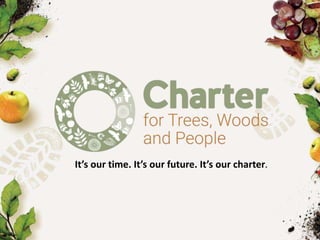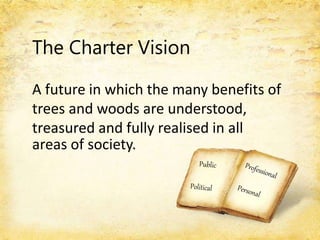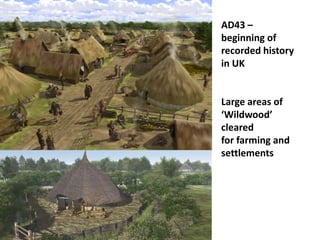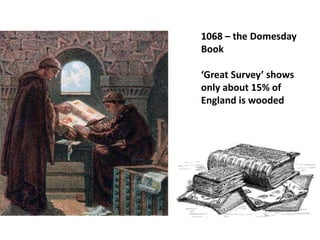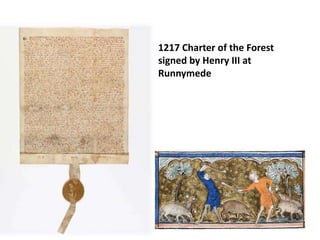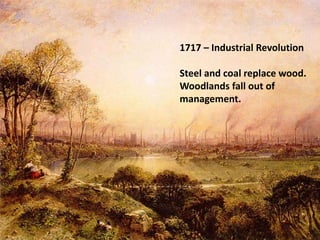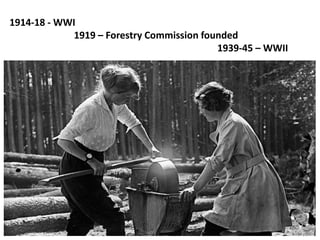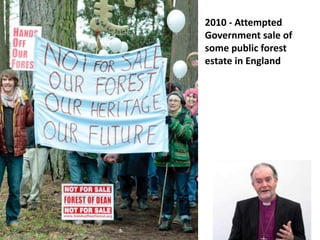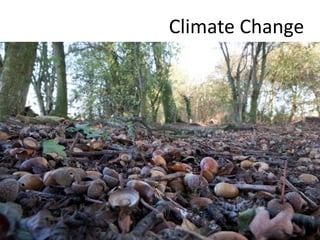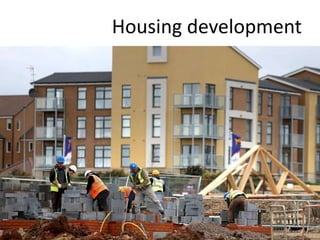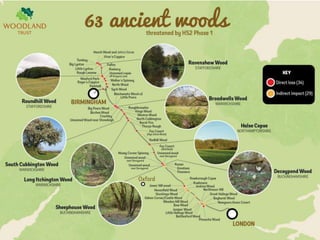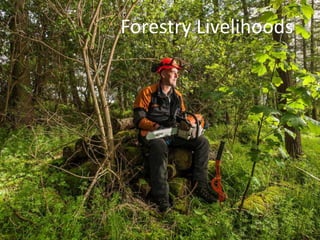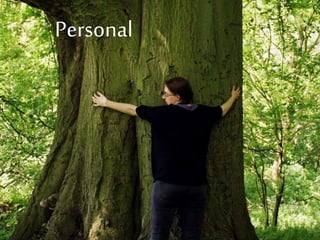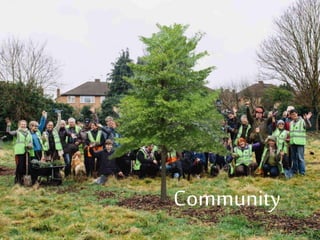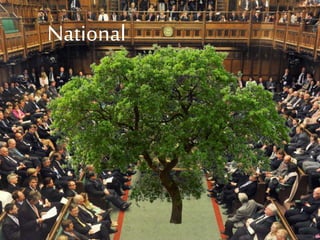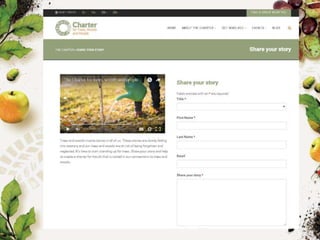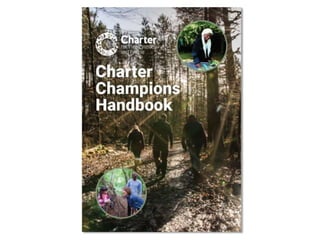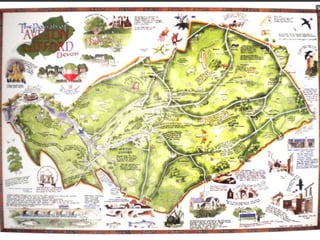Tree Charter Champion presentation
- 1. ItŌĆÖs our time. ItŌĆÖs our future. ItŌĆÖs our charter.
- 4. The Charter Vision A future in which the many benefits of trees and woods are understood, treasured and fully realised in all areas of society.
- 5. Our Mission To lead society in a celebration of the value of trees and woods, and in the creation of a charter that roots the beauty and utility of trees in public consciousness and at the heart of decision-making.
- 6. AD43 ŌĆō beginning of recorded history in UK Large areas of ŌĆśWildwoodŌĆÖ cleared for farming and settlements
- 7. 1st Century AD Anglo Saxon Witans (KingŌĆÖs Councils) held under important trees, such as the Runnymede
- 8. 1068 ŌĆō the Domesday Book ŌĆśGreat SurveyŌĆÖ shows only about 15% of England is wooded
- 9. 1217 Charter of the Forest signed by Henry III at Runnymede
- 10. 1717 ŌĆō Industrial Revolution Steel and coal replace wood. Woodlands fall out of management.
- 12. 1914-18 - WWI 1919 ŌĆō Forestry Commission founded 1939-45 ŌĆō WWII
- 13. 2010 - Attempted Government sale of some public forest estate in England
- 14. 2015-17
- 15. Climate Change
- 20. Screen Time vs Wild Time
- 21. Personal
- 22. Community
- 23. National
- 29. We need you to stick up for trees! ŌĆó Share your story ŌĆó Join or start a local charter group to celebrate Woods and Trees ŌĆó Write a blog or Charter Branch newspaper article ŌĆó Use #TreeCharter on Twitter, Instagram and Facebook Treecharter.uk
Editor's Notes
- #2: People and trees are stronger together ŌĆō but our nationŌĆÖs woods and trees are facing unprecedented pressures from development, disease and climate change. They risk being neglected, undervalued and forgotten. We need to act now before trees disappear from our story. In summer 2015 the Woodland Trust put out an invitation for organisations from across the conservation, environmental, business and social sectors to join a call for a new Charter for Trees, Woods and People. This charter would bring trees and woods back into the centre of public consciousness and political decision-making in the UK. More than 35 organisations answered the call, and have been working with the Woodland Trust to create a national moment for woods and trees. We will establish a legacy of lasting change for the relationship between trees, woods and people. Organisations includes Sylva foundation, RSPB, Black Environment Network, The Tree Council, The Land Trust, Royal Forestry Society, Butterfly Conservation Trust, National Union of Students, National Association of Local Councils and NHS forest. (A full list of organisations involved is available on the charter website). Our ambition is to place trees at the centre of national decision making, and back at the heart of our lives and communities. Once launched in November 2017, the charter will provide guidance and inspiration to allow us all to appreciate, preserve and celebrate our trees and woods. The charter will be rooted in stories and memories that show us how trees have shaped our society, landscape and lives. We need you to share your story with us, to help us create a charter that reflects the true meaning of our trees and woods to the people of the UK. ItŌĆÖs our time. ItŌĆÖs our future. ItŌĆÖs our charter.
- #7: AD43 ŌĆō Large areas of ŌĆśWildwoodŌĆÖ cleared for farming and settlements Graphic ŌĆō farming / building / fire By the time recorded history began in AD43, the wildwood (naturally seeded woodland made up of a selection of species) that covered the UK after the end of the last ice age was already feeling the impact of humans, with large areas cleared for farming and settlements. Trees and woods were an important part of everyday life for the people living across the UK, providing building materials, shelter, food and fuel.
- #8: 1st Century AD Anglo-Saxon land charters had 471 words for woods and their features. Woods were rarely out of thought and daily life. Rivers and trees were sacred to the Anglo-Saxons and Vikings, who recognised how their own lives depended on these valuable natural resources. Anglo-Saxon Witans or KingŌĆÖs Councils were often held under important trees. King Alfred the Great, the Wessex King from 871 ŌĆō 899 AD, held Witans at Runnymede ŌĆō later to be the site of the signing of the Magna Carta in 1215. The name meant ŌĆśRune-MedeŌĆÖ or meadow of magical charms.
- #9: The Domesday Book was created as a manuscript record of the "Great Survey" of much of England and parts of Wales completed in 1086 by order of King William the Conqueror. By this time only around 15% of England was wooded. The Ankerwycke Yew at Runnymede is one of many important ancient trees recorded in the Domesday Book, along with thousands of individual woodlands. This iconic yew, now about 200 years old, still stands today.
- #10: 1217 ŌĆō signing of the Charter of the Forest In 1217, two years after the Magna Carta was signed by King John, his heir Henry III signed the Charter of the Forest. The aim of this document was to protect the rights of people to access and use the Royal Forests, which Norman rulers were increasingly restricting. The Charter of the Forest provides a window to a time in history when access to woods was integral to the life. Being denied access for grazing livestock, collecting firewood and foraging for food was a real concern for the people of the time. ╠² A major concern for common people would have been feeding their pigs through ŌĆśpannageŌĆÖ (knocking acorns down from oak trees so their pigs could eat).
- #11: Up until the start of the industrial revolution in the 1700s, woods were largely managed as a sustainable resource ŌĆō collecting branches from living trees to allow the trees to continue to grow and provide wood for fuel or building materials. In some cases trees were ŌĆścoppicedŌĆÖ, which means that each tree is cut and allowed to regrow so that many slender branches grow from the stump and can be harvested while other trees are growing back. In the industrial revolution, wood started to be replaced by metal, brick and steel as BritainŌĆÖs main building material, and by coal as its principal fuel. People began to move from the countryside to the cities, leaving woods unmanaged and starting to live and work without daily interaction with trees.
- #12: In the 1800s plantation forestry began in earnest ŌĆō developing an industry around the sustainable timber provided by forests of quick-growing non-native conifers. ╠²
- #13: During World War One, Britain was in desperate need of more timber. Imported supplies were being bombed and sunk at sea and local woodland was mismanaged before being controlled by the Forestry Commission. Wood was needed for pit props and acetone production in the Forest of Dean, and ship building nationally. With men fighting on the Western Front, and locally being needed in the mines, women had to take on the role of felling trees, cutting the logs to a desired length and moving them to the railway lines. In 1919 the Forestry Commission was established to expand this industry due to the depletion of forests in England and Wales during the First World War. The first Commission trees were planted on 8 December 1919 at Eggesford Forest, Devon. In the second world war 29,530 acres of Commission forest were clearfelled between 1940 and 1946, with 53,000 acres heavily thinned. The number of people employed rose from 14,000 in August 1939 to 44,300 in February 1941 - including several thousand members of the WomanŌĆÖs Timber Corps, affectionately christened ŌĆśthe LumberjillsŌĆÖ.
- #14: When the UK Government proposed the disposal of some of the public-owned forest in 2010, over half a million people and hundreds of communities rose up and objected. Bishop James Jones, Chair of the independent forestry review panel, says: To say that our woodlands are vital is not an exaggeration. The Panel welcomes this opportunity for the public to think again about the value of trees. There is a huge opportunity for EnglandŌĆÖs woodlands to drive a sustainable economic revival, to improve the health and well-being of the nation, and to provide better and more connected places for nature. As a Panel we have a vision of a more wooded landscape and more woods closer to where people live. There is a place for urban trees, wooded parklands and hedgerows as much as for conifer plantations and small scattered woodlands within a broader landscape. And getting a far greater number of woods, both new and existing ones, managed sustainably is essential. Government, woodland owners, the forestry sector, non-Government organisations, communities and the public all have a role to play. We want the publication of this report to enable the public debate to continue about the future of EnglandŌĆÖs woods and forests, and the social, environmental and economic opportunities that they can deliver. Our forests and woods are natureŌĆÖs playground for the adventurous, museum for the curious, hospital for the stressed, cathedral for the spiritual, and a livelihood for the entrepreneur. They are a microcosm of the cycle of life in which each and every part is dependent on the other; forests and woods are the benefactor of all, purifying the air that we breathe and distilling the water of life. In short, trees are for life. Charter mention: We propose that the public forest estate should remain in public ownership and be defined in statute as land held in trust for the nation. A Charter should be created for the English public forest estate, to be renewed every ten years. The Charter should specify the public benefit mission and statutory duties. It should be delivered through a group of Guardians, or Trustees, who will be accountable to Parliament.
- #15: 2015 ŌĆō The Woodland Trust put out an invitation for organisations from across the conservation, environmental, business and social sectors to join a call for a new Charter for Trees, Woods and People. 2016 ŌĆō Building the charter ╠² ╠² 2017 ŌĆō Launching the Charter for Trees, Woods and People Treecharter.uk is the official website of The Charter for Trees, Woods and People. You can find news and information about the campaign, details of charter events being held near you and a map showing local charter group that you can join.
- #16: Trees face risks due to changing weather patterns and seasons, and the influx of diseases and pests made possible by climate change. Reports show there is already a severe impact on acorn harvests. Trees are essential to making our landscapes more resilient as we face increased threats to people and nature from tree disease and climate change. They need more help, but are more important!
- #18: Phase one of╠²HS2╠²intends to link London and Birmingham. 36 ancient woods will be directly affected with a further 27 at risk of╠²secondary effects such as disturbance, noise and pollution.
- #20: The timber industry contributes to the UK economy and offers sustainable and environmentally friendly building materials, and should be supported and encouraged in policy and practice. (RFS, ICF, Confor, Grown in Britain) Interest in forestry courses has been declining over recent years, raising the threat of a skills gap in the future that could threaten the timber sector and the proper management of woodlands. Increasing the use of wood in construction brings numerous benefits for the environment, the economy and the community. Wood should be considered as the first choice material for all building projects, and planning guidance should be amended to encourage greater timber construction in all publicly funded new-build and refurbishment projects. (Confor, Grown in Britain, ICF, RFS) Wood and CO2 are natural partners. Trees absorb CO2 as they grow so the more forests we plant the more CO2 we can absorb. 1 tonne of carbon is stored for every m3 of timber. Wood from sustainably managed forests can actually be better than carbon neutral. (Confor, Grown in Britain, RFS, ICF, WT) The timber industry is a vital part of our environmental and industrial heritage; it is also a vital part of our low-carbon future.
- #21: kids are spending less and less time outside. Many are growing up in congested, polluted, urban environments, bombarded with advertising and shiny technology and living increasingly sedentary lifestyles. Research shows that the benefits of a re-wilded free-range childhood are significant: Improving their ability to judge and understand risk; Increasing physical health through exercise; Enhancing and maintaining mental health and positive well-being through exposure to the natural world; Stimulating imagination and creativity through outdoor play and learning; Improving communication skills and the ability to build and maintain relationships. Trees encourage outdoor time, provide 3D playgrounds and natural experiences even where green space is limited.
- #22: We need to care about trees so that we notice problems before they are too late, stand up when trees need protection, and so that we benefit from trees in all the ways that we can.
- #23: Trees help communities stay physically and mentally healthy, and help aid recovery from illness or stress. Trees in urban areas are essential. They clean the air, provide natural flood defences, mask noise, calm traffic and promote a general sense of wellbeing. Trees are shared heritage for a community ŌĆō they span generations and provide opportunities for shared experiences. Caring for and improving the green spaces in a community is a great, healthy and enjoyable way to rally together. Charter Champions will aim to bring trees to the heart of communities, but also to remind individuals about the beauty and utility of trees, and what they can do themselves.
- #24: The UK has 13% woodland cover ŌĆō less than any other European country (Woodland Trust, RFS, Confor) Ancient trees and woods are not adequately protected in planning policy. Trees need to be remembered whenever policies are being made ŌĆō they affect all people and all areas of life directly or indirectly yet are so often an afterthought. They need to be protected, but also utilised. They offer solutions as well as facing challenges. Charter Champions will ensure that the charter stands for the whole of the UK and decision-makers will have to take notice.
- #25: Trees and woods inspire stories in all of us. These stories are slowly fading into memory and our trees and woods are at risk of being forgotten and neglected. ItŌĆÖs time to start standing up for trees. Share your story and help to create a charter for the UK that is rooted in our connections to trees and woods. Have you got a treasured memory that wouldnŌĆÖt have been the same without trees? Help us build a charter for the UK that is rooted in our personal connections to woods and trees. ItŌĆÖs easy to share your story. Just visit the charter website (treecharter.uk) and click ŌĆō Share Your Story. We all have tree stories ŌĆō thatŌĆÖs obvious today. We need to help people remember and share theirs.
- #27: Register as a Charter Branch to be a hub for the community and others wanting to act for trees in your local area Web info: Become a Charter Champion and lead your community in calling for a Charter for Trees, Woods and People. Are you involved in a local group, club, council or committee? Could you bring people in your area together to discover and celebrate the woods and trees at the heart of your community? Or would you like to form a new group? As a Charter Champion you will ensure that your community is represented in this historic charter. You will have the chance to inspire your friends, family and neighbours to seize this once-in-a-lifetime opportunity to define the future for woods and trees in the UK. Finding a local group and adding your group to the map is easy ŌĆō just visit the charter website (treecharter.uk) and click Get Involved. You will find guidance and information on the charter website during the campaign to inspire and support your local activities, and to help you create a lasting legacy in your community. Funding will be available for local events, activities and projects that reconnect people and trees now and in the future. YouŌĆÖll be part of a UK-wide network of groups leading local events and you will represent your community in the national conversation about the future of woods and trees.
- #28: Choose the area you represent ŌĆō you could change this as people contribute but it helps to focus! A Gmail account may be useful as you can create a map, add details, and also use the email as a contact email and document storage.
- #29: Mapping ŌĆō define your area Identify important features Layer it with historical, cultural, social and personal stories Maps help people find shared associations and experiences, and to link stories and beliefs with the natural landscape. They are therefore ideal for showing people how the trees around them are relevant and important in their lives.
- #30: The Charter will be launched in 2017. We need your help to build it. Show us what Trees and Woods mean to you today by sharing your stories and getting involved with charter events in your local community. All the information you need can be found on the website ŌĆō Treecharter.uk Tweets and Instagram posts shared with #TreeCharter will appear on the Tree Charter website so it is a great way to ensure your work and the issues important to you is visible in the debate, and to ensure that the website reflects the diversity of issues and involved parties.

